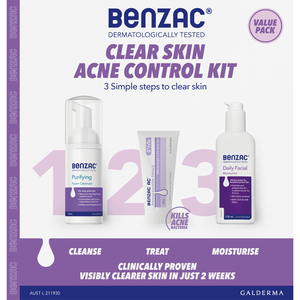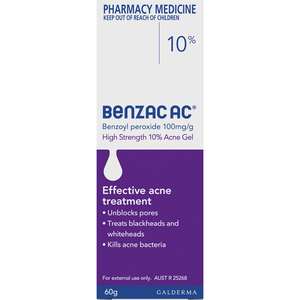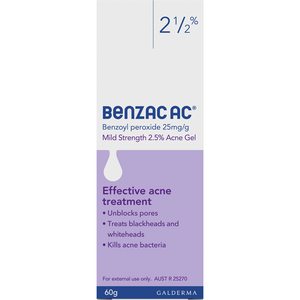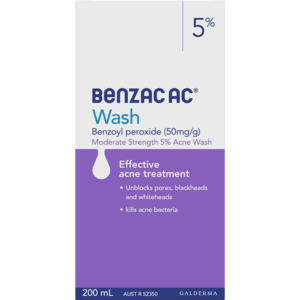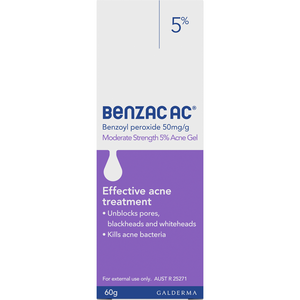Causes, Types & Treatment of Acne in Teenagers
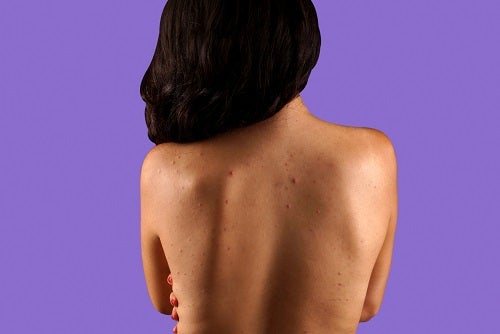
Acne is a chronic skin condition that can appear as spots or pimples on the face and neck as well as the back and chest, often experienced by teenagers. Spots that appear on the skin can contain whiteheads or blackheads, which can cause inflammation and the development of pus-filled pimples. Teenage acne is very common, with 85% of teenagers experiencing the skin condition, especially around the age of 15-24. Whilst acne can be treated with over-the-counter remedies such as creams and skin washes, those who suffer from severe acne may need to consult a doctor for prescribed medical products.
Acne is caused by bacteria within the skin that grows until the pores become blocked. Bacteria found within the skin can build up and produce damaging substances, that when combined with dead skin cells form the visual appearance of a pimple. The buildup of bacteria can be caused by an overproduction of oil by the androgen hormones, affecting the pores in the neck, back, face and chest. A reason teenage acne is prevalent is due to a spike in androgen levels during puberty. It is important to know that hormone imbalances are not the only cause of acne, as stress, diet, hygiene and lifestyle can also cause the skin condition.
There are four main symptoms of acne which include whiteheads, blackheads, pimples and nodules. Whilst these symptoms are mainly experienced on the face, they can occur on other body parts such as the back, chest and neck. Whilst acne is treatable, severe acne can cause scarring due to deep inflammation of the nodules[1].
Different types of acne, and who suffers from them?
There are four types of acne that can be experienced. Starting from the mild side of the scale moving up towards the severe end, there are blackheads, whiteheads, papules and pustules, and cysts and nodules. It is important to know how to treat your type of acne and know what is causing it. Individuals going through either teenage acne, adult acne, or pregnancy acne can experience different causes and require alternate methods of treatment[2].
1. Mild Acne
Mild acne is very treatable, whilst it can be irritating home remedies, general treatment creams and gels as well as good hygiene can clear the skin. Whiteheads may occur when the pore is blocked due to dead skin cells and excess oil surrounding the hair follicles. Benzac AC offers a range of treatments and daily use products to keep you in control of your acne. Early treatment and the incorporation of a skincare routine can help ease mild acne. By minimising the use of heavy makeup and oil-based products, pores are less likely to clog minimising the chance of developing mild acne[3].
As always, if you have acne concerns you should speak to your health care professional for advice.
2. Blackheads
Blackheads are still a mild form of acne, but occur due to the blocked pore opening causing a chemical reaction. Due to this chemical reaction, the surface around the pore darkens, forming a blackhead. If you have attempted to use treatment and preventative products and the acne does not ease after eight weeks, it may be appropriate to consult your GP.
3. Moderate to severe acne
If you suffer from or have noticed the appearance of papules and pustules, you are experiencing a moderate form of acne. At this stage, contacting your GP might be the right move if you struggle to minimise the presence of acne. Papules are reddish raised bumps that irritate the skin, if they develop further pustules can occur. Pustules are a papule with a white centre.[4].
Severe acne can be quite painful, requiring you to visit a dermatologist. Cysts and nodules can form if acne goes untreated and bacterial infection is present. [5]. These large, deep and painful lumps can cover large areas of the face and body and can cause pain. At this stage, it is important to contact your GP, as severe acne won't necessarily respond to over-the-counter treatments. You may be referred to a dermatologist who can further assess your condition and suggest how to approach the next steps.
4. Teenage acne
Teenage acne affects 85% of teenagers and can be linked to an increase in the androgens, a hormone that affects the production of oil and the size of the glands. It is important to incorporate a healthy skincare routine to minimise the risk of acne. This can include cleaning and moisturising the skin, using sun protection, as well as incorporating exercise and a healthy diet[6].
5. Hormonal Acne
Adult acne tends to affect women over men and can be linked to hormones, family history and stress. When it comes to treatment, there is a wider variety of options for adults compared to teenagers. Depending on the cause of acne, prescribe hormonal control treatments, as well as light therapies and general over-the-counter treatments, can be used. If you are unable to manage your acne, reach out to your GP or dermatologist to find your next steps[7].
Sometimes pregnancy can prompt or affect acne, most likely due to hormonal changes. During the first trimester of pregnancy, people can experience dramatic hormonal changes, which can lead to acne flare-ups. It is important to know which treatments to implement, as many are to be avoided during pregnancy. If you experience acne at any point during your pregnancy, you should contact your GP to find out how to approach treatment[8]
Causes of acne
1. Bacteria and acne
Cutibacterium acnes (C.acnes) is a bacterium that appears in areas close to the sebaceous glands. Whilst this form of bacteria is slow growing and harmless, generally keeping the skin healthy, it can cause acne when disruption of the skin microbiota occurs, causing the C.acnes to overgrow. As a pore becomes blocked with oils and dead skin cells, C.acnes begin to thrive. As this reaction occurs, skin around the pore can become inflamed and red, irritating the skin. If not treated appropriately at the mild stage, acne caused by bacteria can evolve into pustules and cysts. It is important to consult your GP to find out your best treatment options[9].
2. Make-up and acne
Applying make-up is a part of an everyday routine for many individuals, which can add a challenge when trying to control acne or avoid acne for those who are prone. Many make-up products contain oils and chemicals, which can prompt the occurrence of acne. Using oil-free and fragrance-free products can help avoid clogged pores. Making sure you include a regular skincare routine to remove make-up appropriately is also important as it removes excess oils, bacteria and dirt from the skin. By keeping the face clean, you can avoid the occurrence of acne and irritation[10].
3. Sunscreen and acne
For a lot of people, there is a concern about a link between sunscreen and acne. Many products may contain oils, fragrances and chemicals that can clog the pores, promoting acne. Whilst this can be irritating, it is important to stay sun smart with suitable products, as sunscreen has many benefits for those who suffer from acne. When taking certain creams and tablet-based acne treatments, the skin can become more sensitive to UV. By using products such as Cetaphil’sTM suncare range, you can ensure your pore won't block whilst protecting your skin from sun damage. With an oil-free, fragrance-free, hypoallergenic formula you can keep sun safe knowing it won't clog pores. It is always important to read the product to see if it suits your needs[11].
4. Acne caused by diet
Maintaining a healthy diet that supports healthy skin is important, as certain foods have the ability to raise your blood sugar faster than others. Due to this reaction, the body releases insulin like hormone, causing your oil glands to overproduce sebum. This overproduction can lead to acne breakouts and inflammation[17]. Foods that are considered high-glycemic (made of simple sugars) should be minimised when trying to control acne breakouts[18].
5. Dandruff and acne
As we know, acne is caused when the pores become blocked with excess oils and dead skin cells. Dandruff can cause acne-causing bacteria to spread to other skin surfaces, prompting the appearance of acne. Whilst dandruff occurs due to conditions such as genetics, environmental conditions and the use of certain products, it can be hard to control. Dandruff tends to occur when the skin is dry, due to the body's reaction the sebaceous glands begin to overproduce sebum oil. With this combination of excess oil and dead skin in the form of dandruff, an acne breakout can occur. Using products such as anti-dandruff shampoo, aloe vera and apple cider vinegar can help control dandruff to prevent acne[12].
6. Acne linked to genetics
Whilst teenage acne can be linked to hormonal factors, adult acne can be closely linked to genetics. Hereditary is said to play a role in acne, with those who have had a first relative experiencing acne being more likely to experience it themself. When both parents of the individual have experienced severe acne, you may have a higher risk of an acne breakout in adulthood[14]. If an individual has a family history of acne, this can be used as a prediction for acne breakouts in teenagers[15]. Genetics can also affect how resistant to acne you are. This is through the immune system and its ability to fight off bacteria[16]. Whilst genetics can affect your chances of acne breakouts, it is still important to maintain good skincare practices.
How to Treat Acne
The best way to treat acne based on each stage is by consulting a medical professional. If you experience mild acne, talk to your pharmacists for guidance on which products would best suit your condition and skin. If your acne is more moderate, it may be time to contact your GP for an in-depth evaluation to determine the next steps. For those who experience severe acne, it is best to consult with your GP and dermatologist to monitor the condition and receive effective treatment. Whilst these are call-to-action responses for treating acne, ensuring you have a regular skincare routine in place can help keep the skin clean and hydrated. By checking what is in the products you are using on your skin, you can determine which are non-pore clogging and the effects of the ingredients they contain. Although acne can be genetic, it is also important to maintain a healthy diet to support the appropriate production of bodily oils and fluids[13].
References
1 Health Direct https://www.healthdirect.gov.au/acne
2 Acne.Org https://acne.org.au/causes/types-of-acne/
3 Acne.Org—mild acne https://acne.org.au/causes/types-of-acne/mild-acne/
4 Acne.Org—moderate acne https://acne.org.au/causes/types-of-acne/moderate-acne/
5 Acne.Org—cystic acne https://acne.org.au/causes/types-of-acne/severe-cystic-acne/
6 Acne.Org—teenage acne https://acne.org.au/causes/types-of-acne/teenage-acne/
7 Acne.Org—adult acne https://acne.org.au/causes/types-of-acne/adult-acne/
8 Acne.Org—pregnancy acne https://acne.org.au/causes/types-of-acne/pregnancy-acne/
9 Health Match—what bacteria causes acne https://healthmatch.io/acne/what-bacteria-causes-acne#all-you-need-to-know-about-cutibacterium-acnes
10 Hopkins Medicine—Acne https://www.hopkinsmedicine.org/health/conditions-and-diseases/acne
11 Acne.Org—Sun smart https://acne.org.au/articles/acne-doesnt-mean-you-cant-be-sun-smart/
12 skinkraft.com-How To Get Rid of Facial Acne Cause By Dandruffhttps://skinkraft.com/blogs/articles/how-to-get-rid-of-facial-acne-caused-by-dandruff
13 healthdirect.gov.au - Acne https://www.healthdirect.gov.au/acne
14pubmed.gov-The familial Risk of Adult Acne: A Comparison Between First-degree Relatives of Affected and Unaffected Individuals https://pubmed.ncbi.nlm.nih.gov/10468803/
15 pubmed.gov-Heredity: a Prognostic Factor for Acne https://pubmed.ncbi.nlm.nih.gov/16484821/
16 pubmed.gov-Acne: A New Model of Immune-Mediated Chronic Inflammatory Skin Disease https://pubmed.ncbi.nlm.nih.gov/25876146/
17 academic.oup.au-International Tables of Glycemic Index and Glycemic Load Values 2021: A Systematic Review https://academic.oup.com/ajcn/article/114/5/1625/6320814
18 pubmed.gov-Current Concepts in Acne Pathogenesis: Pathways to Inflammation https://pubmed.ncbi. nlm.nih.gov/30192343/




